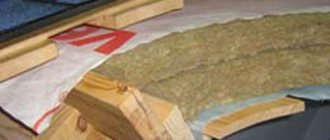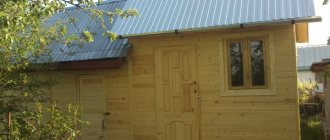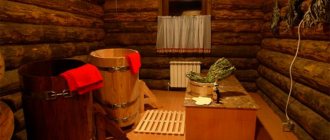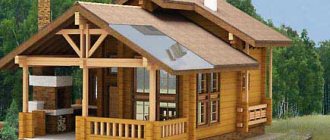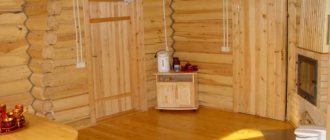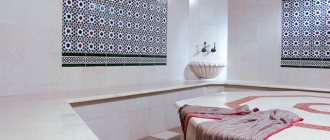Material
Most modern sauna stoves are made of metal. The advantage of this material is fast heating and high heat transfer. Unlike brick stoves, metal stoves do not need to be heated for a long time; they are more compact and easier to maintain.
Modern stoves are made of stainless steel with a chromium content of at least 17% (for example, Ermak Elite), as well as from thick-walled black steel (classic stoves Ermak and Severyanka). Which sauna stove to buy – stainless steel or black steel – depends on your requirements. Modern sauna stoves have a long service life - more than 8-10 years, during which they will delight you with trouble-free operation and ease of use.
Air convection
Almost all modern devices operate on the principle of air convection. Air convection is based on an elementary physical phenomenon: hot air rises to the top, and cold air takes its place.
A stove equipped with a convector casing warms up the room faster and more evenly, as it is capable of passing through and heating a large amount of air in a short period of time. If the oven is not equipped with a convector casing, then it gives off heat to the air without mixing it. It turns out that it is warm near the stove, but colder in the corner of the room.
Thanks to convection, this can be avoided, that is, the air near the stove and in the corner of the room will be approximately the same temperature. The tightness of the combustion chamber primarily affects the slow combustion mode. This is achieved through the use of various seals on oven doors. But seals are consumables. They do not last forever and need to be changed over time.
When the seal wears out, air begins to enter the combustion chamber and control over the combustion mode is lost. Switching the stove to a slow operating mode or smoldering mode, when the stove can operate for several hours on one load of firewood, becomes problematic. Since the smoldering mode occurs with limited air supply to the combustion chamber.
The slow burn mode is very useful. In this mode, we save wood, do not wear out the stove, and maintain the temperature in the room. There are also disadvantages to slow burning. Glass smokes very heavily, no matter what glass cleaning system is used in the oven. Efficiency also drops.
Power
Each stove is designed to heat a room of a certain volume. Depending on the power, furnaces can be divided into 4 groups (let’s look at the example of Ermak products):
| Room volume | Furnace series |
| 6-14 cubic meters | Ermak 12 |
| 8-16 cubic meters | Ermak 16 |
| 12-24 cubic meters | Ermak 20 |
| 15-30 cubic meters | Ermak 30 |
How to choose a sauna stove of the required power? You cannot save money and choose a stove with a power less than what is needed for your steam room. It will work at its maximum capacity, will heat up the room worse and will last a shorter period of time. It is optimal to choose a model that is slightly more powerful than what is needed for your bath. Then the product will last longer and will delight you for many years, quickly warming up the room with minimal wood consumption.
Efficiency
The efficiency factor is defined as the ratio of the amount of thermal energy transferred from the stove to heat the room to the amount of energy that can be obtained from complete combustion of the fuel, expressed as a percentage.
It is clear that the higher the efficiency of the stove, the more heat will enter the room and the less will go into the chimney. The efficiency of furnaces ranges from 60 to 80%. High efficiency is always good, but what makes it so? What new technologies are used in modern furnaces that affect high efficiency and power levels?
The flue gas afterburning system promotes more complete combustion of fuel in the furnace. The combustion of flue gases is carried out by supplying air to different parts of the combustion chamber. From chemistry course we know that oxygen serves as a catalyst for combustion. It then enters along with the air through special channels and flue gases containing carbon particles are burned secondary or tertiary. That is why there is a double and triple combustion system for flue gases. At the exit from the furnace, the flue gases become colder after afterburning, which means that more heat is released into the room and not into the chimney. The higher the degree of afterburning of flue gases, the higher the efficiency indicators! In addition, air rushing into the combustion chamber and igniting in it creates an unimaginable fire show. The quality of firewood greatly affects the thermal efficiency of the heating stove. You should use only dry wood and preferably hardwood. Birch is best. When burned, coniferous wood produces a lot of soot, which sticks to the glass and the inner walls of the pipe. Consequently, you will have to clean the chimney and glass much more often. There is a high probability of this soot igniting inside the chimney. The ignition temperature of soot inside a chimney can reach 1500 degrees Celsius, since it is carbon in its pure form. The chimney will only withstand this temperature for 15-20 minutes, then the chimney is destroyed and there is a danger of fire.
Be extremely demanding on the quality of the fuel you use!
Which stoves are better for a sauna: with a tank or a heat exchanger?
The choice of sauna stove depends on the layout of the sauna. If the washing room is located separately from the steam room, the best solution would be an option with a heat exchanger (for example, Ermak 12T), so that there is no excess steam from boiling water in the steam room. Sauna stoves with a hanging tank can also be used - in this case, the tank drain valve is led from the steam room to the washing room. A hanging tank is especially convenient if you fill the tank with a bucket and don't want to have to reach high.
If the washing room is combined with a steam room, models with a hanging tank (such as Ermak 12B) are optimal. If you want to place the water tank away from the stove, you can use stoves with a heat exchanger.
Optimal sizes and dimensions of a Russian bath, steam room, washing room and dressing room
When building a bathhouse, many owners strictly adhere to all requirements for the configuration and size of the future structure.
The optimal size of the bathhouse ultimately determines the quality of health procedures.
What should be the optimal dimensions of the steam room and shelves? What ceiling height is important to observe when designing a bathhouse?
Layout and overall dimensions
A classic Russian bathhouse consists of a steam room, a washing room, a dressing room and other utility rooms. An electric or wood-burning heater is used as the main heating.
The minimum dimensions of a bathhouse designed for 2–3 people are 1.9 x 2.1 meters. It is equipped with one large bench for performing procedures in a sitting or lying position.
The average bathhouse has the following parameters - 2.6x2.5 meters. For ergonomic use of free space, benches are placed in an L or U-shape around the entire perimeter.
It is important to maintain the optimal ceiling height; the lower it is, the lower the fuel consumption for heating the room.
As a rule, the rest bench is placed at the level of the top of the firebox - 100 cm, therefore, for maximum comfort for vacationers, the optimal ceiling height should be at least 2.4 meters. The height of the bathhouse is determined by the technological features of the project and the overall dimensions of the future structure.
Steam room arrangement
The central room of the bathhouse is the steam room. Its dimensions are determined by the capacity and features of the health procedures - lying or sitting. When calculating the area of the steam room, it is worth taking into account the dimensions of the heater; it often takes up to 1 sq.m. area.
The minimum dimensions of the room are calculated based on the useful square footage intended for 1 visitor - 1.5 sq.m. Thus, for a company of 3 people, the steam room should have at least 5 sq.m. area. The optimal size of the steam room is determined taking into account the height of the tallest visitor - for example, 190 cm.
The main functional element of the steam room is a bench, the dimensions of which depend on the area of the room and the personal preferences of the vacationers. For sitting procedures, the width of the bench is at least 45 cm, while lying down – up to 95 cm.
The optimal size of a steam room for a company of 3–4 people is 5–6 sq.m. It is allowed to increase the usable area, but in no case should it be reduced.
Experts recommend installing electric heaters in small steam rooms, and wood-burning metal stoves in large rooms. This will ensure maximum intensity of thermal radiation with minimal costs for electricity and fossil fuels.
Bench dimensions
The optimal dimensions of benches installed in steam rooms are determined by the functional features of their use:
If there are up to three benches in the steam room, then the lowest of them should have the minimum width. It is intended for children or laying out accessories and supplies for procedures.
The optimal distance between the upper bench and the ceiling does not exceed 1 meter.
There should be small gaps of 0.35 cm between the individual wooden elements from which the benches are made for mandatory air convection.
Features of the washing machine
Washing room is a room intended for carrying out ablution procedures. There are open tanks with hot and cold water, benches for sitting, showers and a cooling font.
The dimensions of the washing room are determined as follows - 1 sq.m. per visitor.
For a company of 4 people, a room with an area of 2x2.5 meters is suitable. For two people, a washing area of 1.7x1.4 meters is sufficient.
Dimensions of the waiting room and rest room
The dressing room is a special locker room, which is located directly in front of the steam room or washing room. Some projects involve combining a dressing room with a rest room.
In the dressing room, visitors undress and prepare for basic procedures, and also rest after washing.
Most dressing rooms contain benches, chairs, mirrors and clothes hangers. Some are equipped with compact pools for thermal treatments. For massage lovers, a special trestle bed can be installed. There are also all kinds of utensils for health procedures - buckets, ladles, fuel for heaters.
In an average bathhouse, the dressing room has the following dimensions - 20 sq.m., in small buildings - up to 6 sq.m.
It is recommended to equip a separate recreation room in medium and large buildings. Some projects provide for open or closed terraces, which in most cases are used as recreation rooms.
For a company of 4 people, a rest room of 8 sq.m. is enough. It can easily fit a compact table, chairs and even a folding sofa. Additionally, you can equip a place for holding a tea ceremony. For companies for 6–10 people, it is better to provide a room up to 15 sq.m.
Arrangement of doors, windows and lighting
The size of the doors is not an unimportant parameter when arranging such a structure. The recommended dimensions of doors with one leaf are as follows: width – 75 cm, height – 175 cm.
To retain heat, the floor in the steam room should be 22 cm higher than in the washing room. It is recommended to install a door that opens outward with a high threshold.
Small and compact steam rooms do not have a window to prevent possible heat loss.
In large steam rooms, it is recommended to install low windows located closer to the floor. The window dimensions are 35x35 cm. It is better to provide a paired method of placing windows on the wall opposite the heating device.
This arrangement promotes proper accumulation of steam under the ceiling and prevents it from mixing with cooled air above the floor level.
When designing a bathhouse, special attention should be paid to proper lighting of the steam room. Lamps should not be overly bright so as not to tire the eyes. It is recommended to choose devices intended for use in rooms with high humidity and temperature changes.
Thus, the most suitable dimensions of the steam room and washing room can be selected, taking into account the maximum number of visitors, their gender and age, as well as the operational characteristics of the heating equipment.
How to correctly determine the optimal size of a future bathhouse. What dimensions should the main rooms have: steam room, washing room and dressing room. Suitable ceiling height and bench size for ease of procedures.
Tank size and fitting location
When choosing a tank for a stove with a heat exchanger, pay attention to the correct location of the fittings so that there are no problems when connecting the heat exchanger to the tank. Also pay attention to the shape and size of the tank. Washing rooms are often small and standard tanks can be too bulky. In this case, it is better to order a custom-made stainless steel tank. The tank should be taken in accordance with the recommendations in the instructions, otherwise there is a chance that it will take too long to warm up.
So, these are all the points that need to be taken into account when choosing which sauna stove to buy. Now you are ready to purchase a good stove that will delight you for many years. But in order for the stove to serve for a long time, it is important to install it correctly.
Glass cleaning system
Separately, I would like to dwell on the glass cleaning system. There are several systems:
- Cleaning glass with cold air.
This is done through the gap between the glass and the cast iron frame of the stove. Air flows from top to bottom, creating a barrier between the source of ignition and the glass. The disadvantage is that carbon deposits remain on the glass, which are very difficult to clean.
- Glass cleaning with hot air (CB).
In my opinion, the most effective glass cleaning system. The air into the firebox is supplied already hot, thanks to the double body of the furnace. Through special channels in a double housing, air is supplied to the glass and cuts off soot from the glass.
- Double glass.
The effect is better than cleaning glass with cold air, but there are additional cleaning difficulties due to double glass. — pyrolysis spraying. This coating on glass, in the form of a film, protects the glass from the formation of soot on it. But it burns out over time and the effect disappears.
